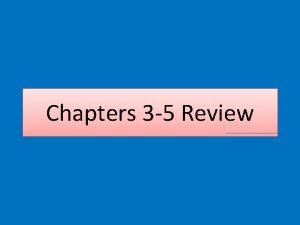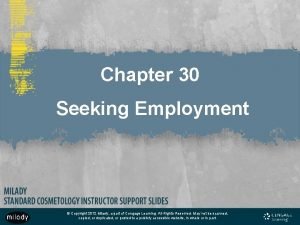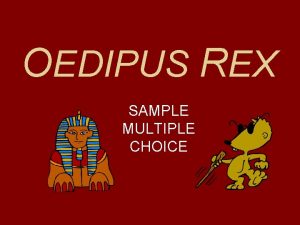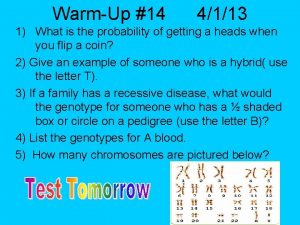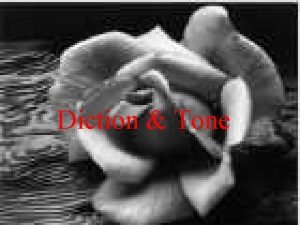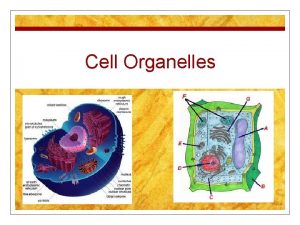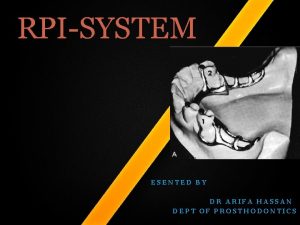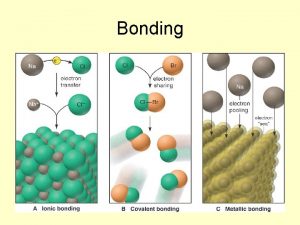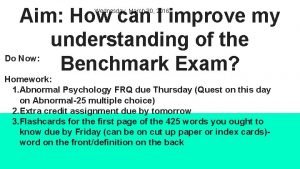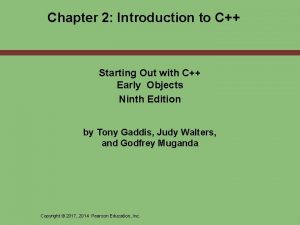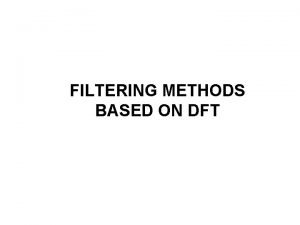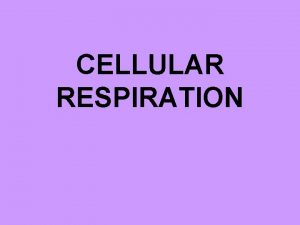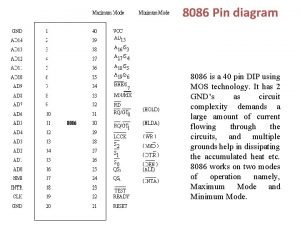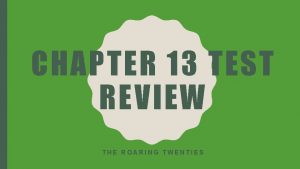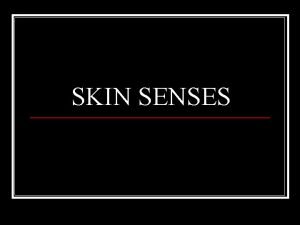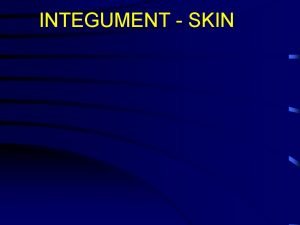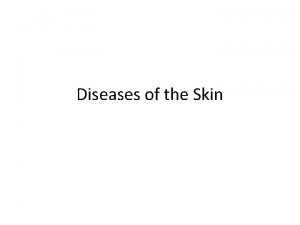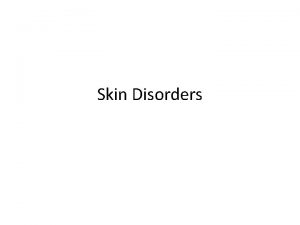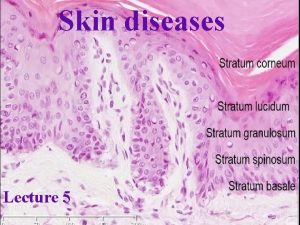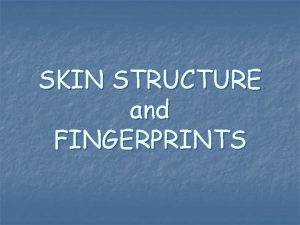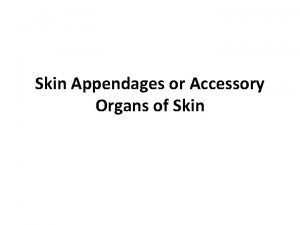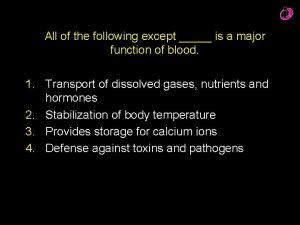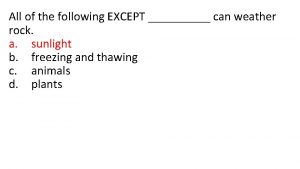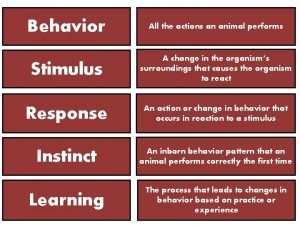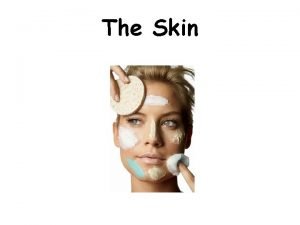The skin performs all of the following except














































- Slides: 46

The skin performs all of the following except a. PRODUCTION OF CHEMICAL b. c. MESSENGERS ELIMINATION OF WASTE PRODUCTS CONTROL OF BODY TEMPERATURE d. PROTECTION

Students will know… Explain what an action potential is? K+ ions are entering the neuron Negatively charged proteins are leaving the neuron Na+ ions are entering the neuron The myelin coat has broken down and ions are crossing freely

Students will know… Which is the correct path a nerve impulse will follow in a reflex arc? Put these three terms in order Motor neuron, sensory neuron and interneuron

Nervous System Chapter 33. 1

Structure of the Nervous System Neurons conduct electrical impulses allow cells, tissues, and organs detect and respond to stimuli

Neurons Specialized cells Help you gather information

Neuron

Neuron Dendrites – receive signals and send them to the cell body

Neuron Dendrites – receive signals and send them to the cell body Cell body – nucleus of the neuron and other organelles

Neuron Dendrites – receive signals and send them to the cell body Cell body – nucleus of the neuron and other organelles Axon – caries the nerve impulse from cell body to other neurons and muscles

Reflex Arc Nerve pathway Basic structure of the nervous system Sensory neuron to an interneuron, and a motor neuron

An Action Potential Nerve impulse A stimulus reaches threshold Channels in the plasma membrane open Potassium ions leave the cell Change in charge moves

Action Potential

Which of the following pairs lists the fiber-like extensions that are components of neurons? a. AXONS AND MYELIN b. SYNAPSES AND MYELIN c. DENDRITES AND SYNAPSES d. DENDRITES AND AXONS

Organization of Nervous System Chapter 33. 2

Organization of the Nervous System Central nervous system Peripheral nervous system

The Central Nervous System CNS Spinal Cord Brain Relays messages Processes information Analyzes responses

The Brain Made up of 100 billion neurons Maintains homeostasis Control center

The Brain Made up of 100 billion neurons Maintains homeostasis Control center Homeostasis – maintains a constant condition

The Brain

The Brain

Cerebrum Largest part Divided into two hemispheres Thought process of memory, language, speech, voluntary body movements and sensory perception

Cerebellum Controls balance, posture and coordination Back of brain

Brain Stem Connects the brain to the spinal cord Made up of Medulla oblongata (signals between brain and spinal cord) Pons (signals between cerebrum and cerebellum)

Spinal Cord Nerve column from your brain to the lower back Protected by vertebrae

Spinal Cord

The Peripheral Nervous System Somatic Nervous System Autonomic Nervous System

Somatic Nervous System Relays information to and from skin and skeletal muscles Voluntary

Autonomic Nervous System Relays information to internal organs Involuntary

Autonomic Nervous System Sympathetic Parasympathetic Pupil dilation Pupil constriction Heart rate increased Heart rate decrease Bronchial muscles relaxed Small intestine muscle contractions reduced contracted Digestion increased

Unit 9 CHAPTER 33. 3

Quiz 1. Draw and label a neuron 2. Describe a Reflex Arc Pathway 3. Describe an Action Potential

The Senses Chapter 33. 3

The Senses Sensory receptors allow you to detect the world around you

Taste and Smell Stimulated by chemicals Work together

Smell Sensory receptors high in the nose Respond to chemicals Signal the brain

Taste buds Detect sweet, sour, salty and bitter

Nature August 2006 Wrong!

Sight Light enters the eye Through the cornea Behind the iris is the lens To the retina (rods and cones) Signals sent to brain Brain interprets

Sight

Hearing and Balance Function of the ear Volume Highness and lowness

To Hear Sound waves Ear canal Eardrum to vibrate Through the malleus, incus, stapes Inner ear cochlea Sends signals to the brain

Ear

To Balance Cochlea Semicircular Canals At 900 Fluid filled, lined hairs Head moves the fluid moves and sends signals to brain

Ear

Touch Sensory receptors Respond to temperature pressure and pain Epidermis and dermis Tips of fingers have lots Not everywhere
 The skin performs all of the following except
The skin performs all of the following except Ethan is observing chemical and physical properties
Ethan is observing chemical and physical properties All of the following accurately describe hadoop except
All of the following accurately describe hadoop except All of the following account titles are asset titles except
All of the following account titles are asset titles except Milady chapter 30 test
Milady chapter 30 test Jupiter is noticeably oblate because:
Jupiter is noticeably oblate because: Mercury's surface most resembles which of these
Mercury's surface most resembles which of these The man makes all the following mistakes except
The man makes all the following mistakes except The plot of oedipus deals mainly with
The plot of oedipus deals mainly with A punnett square shows all of the following except
A punnett square shows all of the following except Internal external respiration
Internal external respiration Strict constructionists favored congress exercising
Strict constructionists favored congress exercising Thick skin and thin skin
Thick skin and thin skin Thin skin vs thick skin
Thin skin vs thick skin Milady chapter 23 pdf
Milady chapter 23 pdf All children except one grow up
All children except one grow up This organelle contains pigments of all colors except green
This organelle contains pigments of all colors except green Name all the lines name all the segments name all the rays
Name all the lines name all the segments name all the rays Forms of poultry
Forms of poultry The following are examples of nonmaterial culture except
The following are examples of nonmaterial culture except Spread and fillings
Spread and fillings Solutions are …….dosage form *
Solutions are …….dosage form * I bar clasp system
I bar clasp system Cyanate ion formula
Cyanate ion formula User defined function in qbasic
User defined function in qbasic Becker & smith cpas performs
Becker & smith cpas performs Elizabeth picks up the clothes from her bedroom floor
Elizabeth picks up the clothes from her bedroom floor Whom does mercutio curse as he lies dying after a duel
Whom does mercutio curse as he lies dying after a duel This operator performs integer division.
This operator performs integer division. 8bit gaurav
8bit gaurav Linear filtering methods based on dft
Linear filtering methods based on dft What type of cell performs cellular respiration
What type of cell performs cellular respiration Ready pin in 8086
Ready pin in 8086 Front end and back end of compiler
Front end and back end of compiler Why did marcus garvey's movement fall apart
Why did marcus garvey's movement fall apart A computed is a calculation that a dbms performs
A computed is a calculation that a dbms performs A chemist performs the same tests on two
A chemist performs the same tests on two Hình ảnh bộ gõ cơ thể búng tay
Hình ảnh bộ gõ cơ thể búng tay Bổ thể
Bổ thể Tỉ lệ cơ thể trẻ em
Tỉ lệ cơ thể trẻ em Gấu đi như thế nào
Gấu đi như thế nào Tư thế worms-breton
Tư thế worms-breton Chúa yêu trần thế alleluia
Chúa yêu trần thế alleluia Môn thể thao bắt đầu bằng từ chạy
Môn thể thao bắt đầu bằng từ chạy Thế nào là hệ số cao nhất
Thế nào là hệ số cao nhất Các châu lục và đại dương trên thế giới
Các châu lục và đại dương trên thế giới



